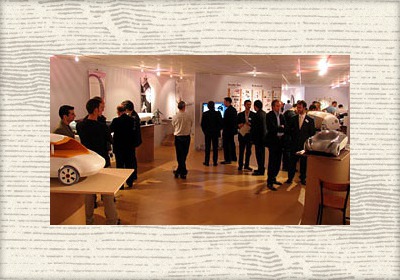College Exhibition: Royal College of Art Show 2004
Tue, 05 Oct 2004 Oct 5, 2004 - Seventeen final year students at London's Royal College of Art postgraduate Vehicle Design course displayed their work in the second part of the internationally renowned annual summer show.Go to Photo Gallery
240 photos
The Show: Two featured the work of students in Vehicle Design, Design Products, Industrial Design Engineering, Architecture and Interiors, Computer Related Design, Textiles, Animation, Communication Art and Design, Conservation and History of Design.
Linda Andersson presented 'Punk', a Ford V8 sports car aimed at drivers aged 45-60, who can afford expensive products. Linda explains: "I wanted to rebel against the 'blank car'. This is a car with a personal 'face' which strives to fulfill the user's yearning for individuality." The form inspiration came from a toothpaste tube - with a soft end and a hard agressive top - and a gun, with its mechanical front and ergonomic wood and rubber rear. The front of the vehicle features an interchangeable gunmetal-finish nose section, and at the rear the surfaces are covered by black rubber.
Heung Soo Kim's coupe concept explores 'light as communication', with intuitive gestural driver controls, simplified instrumentation using color-coded indicators and exterior lamp elements embedded within the vehicle's glass surfaces. The project was presented as a scale exterior, featuring laminated ebony on a metal frame, and a full-size interior model, with laminated, formed and milled wood seats.
For the 17th year Pilkington Automotive sponsored the Royal College of Art's Vehicle Design Awards. Jussi Timonen, from Finland, won the award for the most innovative use of glazing for his G.Util design, with the glass playing both an aesthetic and a functional role, acting as protection for the hydrogen fuel tank. With its integrated luggage, the vehicle was also inspired by the stress of frequently moving house. Jussi explains: "In today's society, many people are constantly moving around, working six months at a time in different places. The motorised luggage is designed to make this process much easier - it will follow you and load itself into the car!". The vehicle also features four identical wheel/suspension/motor units which can be attached to any location, greatly simplifying servicing by allowing a simple swap-out of almost all the complex mechanical systems.
Steve Mattin, Senior Design Manager at DaimlerChrysler, explains the judges' reasons for choosing the G.Util: "Jussi's design really stood out because he had considered feasibility issues he might face when putting the vehicle into production. For example, he had extended the windscreen to overcome visibility issues and he also got us all thinking about the possibilities of his complex glass doors that fold underneath the vehicle when they open."
Commendations in the most innovative use of glazing category also went to Heung-Soo Kim for his design 'Pleasure before your eyes' which explores the use of light and colour, as well as to Tobias Nagel for Panta Rei, a mobility system for metropolitan waterways.
This year's winner of the Pilkington Automotive Best Design Interpretation Award was Heikki Naulap?? from Finland for his Aprilia Magnet design, a crossover between a motorbike and an open-seater sports car.he Best Design Interpretation Award is presented to the student whose vehicle visually and practically best interprets the design intent. It should explore the limits of the vehicle design, considering both the requirements of industry as well as being able to face tough styling competition.
The prize of ?2000 was presented to Heikki by Tony Hunter, Assistant Chief Designer for Interiors from Land Rover and one of the judging panel. Heikki explains the inspiration behind his Aprilia Magnet concept: "I wanted to create a new riding sensation with this design - capturing the tilting movement of a motorcycle, combined with the low seating position of a sports car. The driver also has the ability to adjust the visibility of the glass at the side, contributing to the thrill of the ride."
Tony Hunter explains the reasons for choosing the Aprilia Magnet as the winning design: "We were all unanimous on the judging panel that we wanted to drive the vehicle as soon as we saw it. Heikki has made an excellent job of taking a concept that almost all car designers have a longing to do, and endowed it with a tactile allure which demands that you hop on and fully experience the driving sensations it offers."
Commendations in the Best Design Interpretation category also went to Jussi Timonen for G.Util and Thomas Eaton for his revolutionary bicycle design.
Thomas Eaton proposed a cheap-to-make and fully recyclable bike that could be used for public transport or custom-built for promotional campaigns. Thomas explains: "I set out to identify and capture the true essence of a new, modern bicycle. To understand the inherent nature of the object, to exploit the benefits of advanced materials, and the possibilities of cost-efficient mass-production, in order to give the bike an appropriate personality and character for contempary cycling". The main structure of the bike uses a new heat forming technique which uses only polypropylene with no additive resins, allowing for easy recycling.
By

